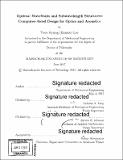| dc.contributor.advisor | Nicholas X. Fang and Steven G. Johnson. | en_US |
| dc.contributor.author | Lee, Yoon Kyung (Yoon Kyung Eunnie) | en_US |
| dc.contributor.other | Massachusetts Institute of Technology. Department of Mechanical Engineering. | en_US |
| dc.date.accessioned | 2017-10-04T15:06:02Z | |
| dc.date.available | 2017-10-04T15:06:02Z | |
| dc.date.copyright | 2017 | en_US |
| dc.date.issued | 2017 | en_US |
| dc.identifier.uri | http://hdl.handle.net/1721.1/111734 | |
| dc.description | Thesis: Ph. D., Massachusetts Institute of Technology, Department of Mechanical Engineering, 2017. | en_US |
| dc.description | Cataloged from PDF version of thesis. | en_US |
| dc.description | Includes bibliographical references (pages 149-164). | en_US |
| dc.description.abstract | The aim of the research presented in this thesis is to design optimal wavefronts and subwavelength structures that enhance mechanical effects on the nanoscale, focusing on three types of devices: holographic optical tweezers, broadband solar absorbers, and acoustic waveguides. Much of the work presented is obtained using open source software tools. Advances in spatial wave modulation and nanomaterial fabrication technologies have created many new degrees of freedom for engineering wave-matter interaction. When exploring so many parameters, a large number of full-wave scattering problems must be solved efficiently - calling for a more targeted design approach. We address this challenge by offering computer-automated design frameworks that effectively combine the best computational software developed in physics, numerical analysis, and inverse design. Part I presents computational inverse design methods for structured illumination in holographic optical tweezers. Wave optimization is highly nonconvex by nature, and possesses many local optima due to interference and resonance. By combining a compact Bessel basis and a fast boundary element method, we achieve a 20-fold enhancement in torque per intensity, over a standard circular-polarized illumination, on a model plasmonic nanoparticle. Part II presents mode analysis and numerical parameter-testing strategies for periodic subwavelength structures in optics and acoustics. We first summarize the design and experimental characterization results of a photonic crystal solar absorber with wide-angle spectral selectivity. Next, we discuss a multiscale acoustic model of a phononic crystal with strong spatial dispersion. We are optimistic that our computational frameworks for wavefronts and subwavelength structures can be generalized and applied to other design problems, such as metamaterials, 3d manufacturing, and 3d imaging. | en_US |
| dc.description.statementofresponsibility | by Yoon Kyung (Eunnie) Lee. | en_US |
| dc.format.extent | 164 pages | en_US |
| dc.language.iso | eng | en_US |
| dc.publisher | Massachusetts Institute of Technology | en_US |
| dc.rights | MIT theses are protected by copyright. They may be viewed, downloaded, or printed from this source but further reproduction or distribution in any format is prohibited without written permission. | en_US |
| dc.rights.uri | http://dspace.mit.edu/handle/1721.1/7582 | en_US |
| dc.subject | Mechanical Engineering. | en_US |
| dc.title | Optimal wavefronts and subwavelength structures : computer-aided design for optics and acoustics | en_US |
| dc.type | Thesis | en_US |
| dc.description.degree | Ph. D. | en_US |
| dc.contributor.department | Massachusetts Institute of Technology. Department of Mechanical Engineering | |
| dc.identifier.oclc | 1004375679 | en_US |
